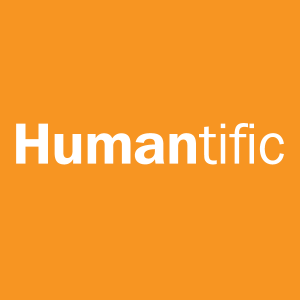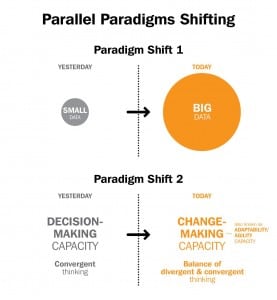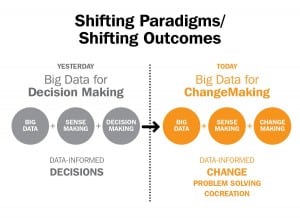 GK VanPatter, co-founder of Humantific, shifts the data visualization conversation to examine a couple of ideas that underlie how it may inform broader agendas. That is: in addition to high value communication, GK suggests that, by way of co-creation, visualized data can play a bigger role. (“Wait! What’s co-creation?”) Well, you’re familiar with it already: It’s moving from the typical one-way conversation (company to people) toward an interactive conversation with the people who matter to you – clients, customers, constituents with whom (according to this wikipedia definition) you engage to “share, combine and renew each other’s resources and capabilities to create value through new forms of interaction.” Let’s see.
GK VanPatter, co-founder of Humantific, shifts the data visualization conversation to examine a couple of ideas that underlie how it may inform broader agendas. That is: in addition to high value communication, GK suggests that, by way of co-creation, visualized data can play a bigger role. (“Wait! What’s co-creation?”) Well, you’re familiar with it already: It’s moving from the typical one-way conversation (company to people) toward an interactive conversation with the people who matter to you – clients, customers, constituents with whom (according to this wikipedia definition) you engage to “share, combine and renew each other’s resources and capabilities to create value through new forms of interaction.” Let’s see.
…
At this point I think most of your audience certainly understands the power of data visualization in terms of helping to make sense of what Richard Wurman often refers to as the “tsunami of data crashing on all of our shores” and to communicate complexity to a wide audience.
In the work that we do with organizational leaders, we have the privilege of working across many industries. In that collaboration we see a lot and learn a lot as waves of change from industry to industry are often not occurring in perfect unison. Like the Markets for Good initiative itself, we are always open to learning from other industries. In reflecting upon this and contemplating how Humantific might best add value here, I will focus this post on the emerging topic of Data Visualizing meets Data Actionizing. It is a movement that is already underway outside the philanthropic ecosystem, so I am assuming that it might be useful to paint at least part of that picture for your readers here today.
Rarely in the history of societal change has one, single, paradigm-shifting phenomenon occurred in isolation. This principle holds true for the Big Data as well, although this is not always clear in the mainstream media coverage. Big Data is occurring, not in isolation, but rather in parallel to numerous other paradigm shifts. Let’s set aside the tactics of Big Data for a moment and consider the bigger strategic picture.
It is no secret that today most organizational leaders are faced with an operational context of continuous external change driving a need for internal change. A rising tide of diverse organizational leaders are coming to the realization that as important as enhancing decision-making is, that improvement in itself will not result in the much-needed capacity to adapt in a continuously changing world. Even the graduate business schools have begun to figure out that in a continuously changing world, more than decision-making (convergent thinking) expertise is going to be required.
Whether you want to call this sought-after capacity “resilience”, “adaptive, innovation” or “change-making” makes less difference than recognizing the fundamental mechanics of what is inside. To get to sustainable resilience requires the combined, orchestrated capacity for widening divergent thinking and narrowing convergent thinking working within a results-oriented intervention framework. Would you buy a car with only a brake pedal? I think not. It is the realization that convergent thinking (decision-making) expertise is no longer enough that is playing itself out in parallel to the Big Data wave in every industry. Explicitly or implicitly, it is this shift combo that is at the center of what many organizational leaders are grappling with today.
 Map that strategic adjustment to the realization that planet earth faces rising complexity of problems and we land squarely in the high-profile social change initiative that was recently launched: “No Ceilings / The Full Participation Project.”
Map that strategic adjustment to the realization that planet earth faces rising complexity of problems and we land squarely in the high-profile social change initiative that was recently launched: “No Ceilings / The Full Participation Project.”
I watched via live stream and noted the arc of the conversation (featuring three change-makers: Hillary Clinton, Melinda Gates, Chelsea Clinton) bending toward the use of data to inform a range of change-maker intervention activities, not just decision-making. Listen closely to that conversation with your “innovation” hat on, and you will hear keen interest in using data to inform problem-finding, challenge-defining and more.
Hillary Clinton, noting that, “We want to help people solve problems so they have better futures,” is already weaving the multiple change waves together in that initiative. The three panelists spoke of using visualized data to inform the creation of a “better opportunity agenda,” i.e. in co-created problem solving, not just for enhancing decision-making. Clinton is not alone in this approach: data thinking meets problem/opportunity framing, problem solving and co-creation.
This shift towards considering data in the context of broader change making is already underway across many industries and, perhaps most importantly, across numerous generations who are now involved in redefining leadership.
For an extended treatment of this post, see: Data Visualization Meets Co-Creation
There, you will also find the following:
- Humantific Survey / Social Sector Challenge Mapping
- From the 10 challenges listed in the attached document, choose 3 challenges that are most important to your organization right now and place them in chronological order of importance (with most important at the top). If you have another challenge not listed, feel free to add it to your list. We will share the results.
Related Resources
…
Thanks for inviting us to contribute to this always-shifting subject being discussed here on this important platform. Humantific is proud to have been involved in Markets for Good since the early days, via work wth the Liquidnet leadership team and having facilitated early Markets for Good group gatherings. We are always happy to engage in this community! GK VanPatter


